|



| |

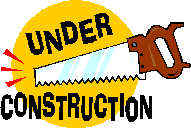
The Warren Commission tells us that Oswald also killed Dallas
Police Officer J D Tippit.
The official records prove this charge
False also.
Oswald's housekeeper Earlene Roberts,
stated that Oswald came home at 1:00 or a little after. See audio
page. She stated that while Oswald was in his room a Police car
stopped out front & beeped the horn twice.
She stated he left in 3 or 4 minutes.
(see below) She said shortly after he left she looked out the window & saw
Oswald
standing by the bus stop.
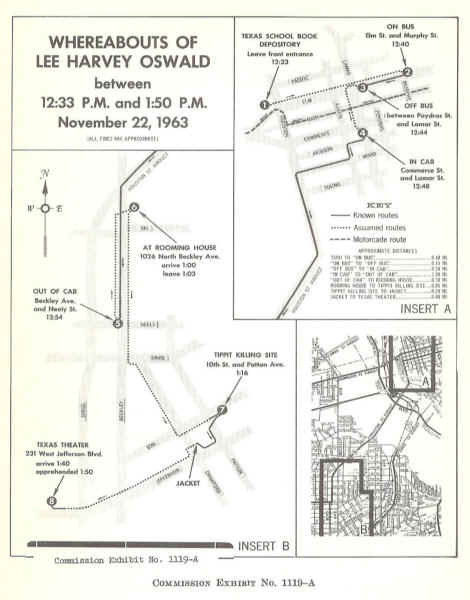
Star witness Helen Markham stated that she was on her way to
catch the 1:15 bus down on Jefferson to go to work.
She arrived at the corner of 10th & Patton at 1:06 & witnessed Tippit's murder. see below.
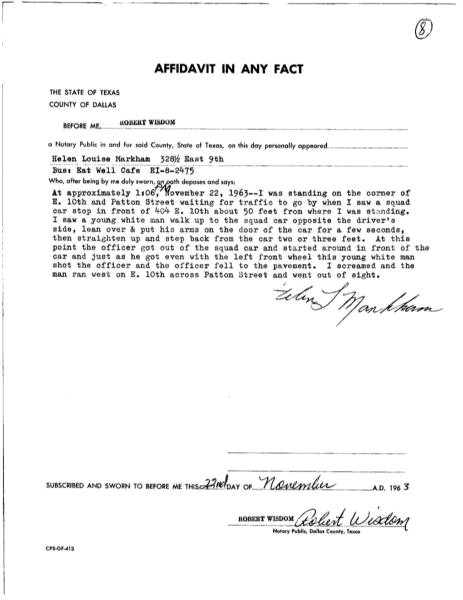
Helen Markham was going to catch her 1:15 bus to work on
Jefferson one block away.
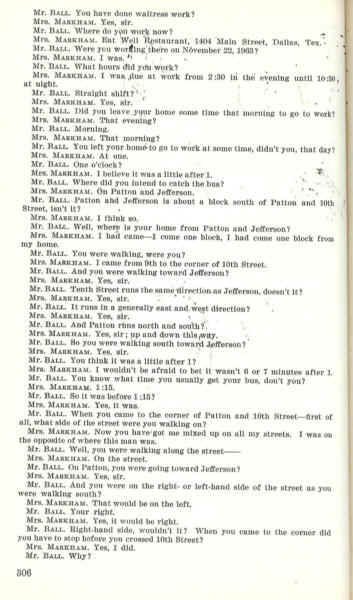
The timing is buttressed by T F Bowley. see below.
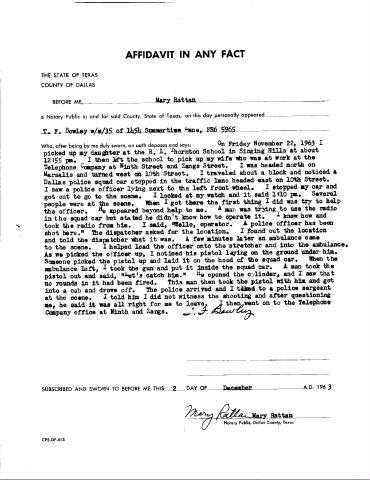
Thanks to Sammy G>>> Sammy G. <unome_gldd@yahoo.com>
Below is Tippit's Death
Certificate.
Tippit's body was taken to methodist
Hospital & arriving at 1:15.
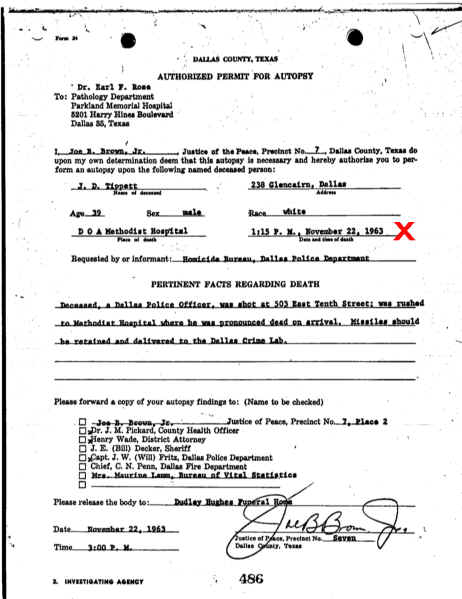
Pronounced Dead at 1:15.
Autopsy Finish at 3:00 p.m.
Below from Commission Document
#5 (pronounced dead @ 1:25)

tippit was pronounced dead at the hospital at 1:15 p.m.
asa sees here>

threWarren Commission use that time as time of the shooting
because they knew oswld didn't have time to arrive in time of the shooting at
1:07.
 From HSCA V olume VIII From HSCA V olume VIII
From Oswald's rooming house to the Tippit murder scene is 0.85
miles.
Do they really want us to believe that Oswald was "The
Fastest Man in the World"?
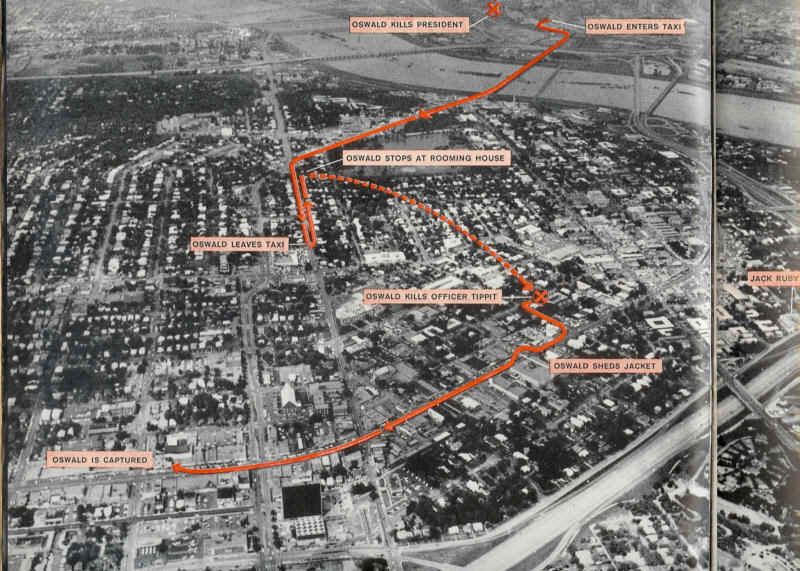
BTW; It was NOT Oswald's jacket found in the used car
lot. The jacket found had a Cleaner's tag on
it.Marina testified that she always washed his jackets.
SEE timing for Oswald.
http://www.youtube.com/watch?v=uf8D6NuLIhw
Tippit shells NOT ID'd. (below)
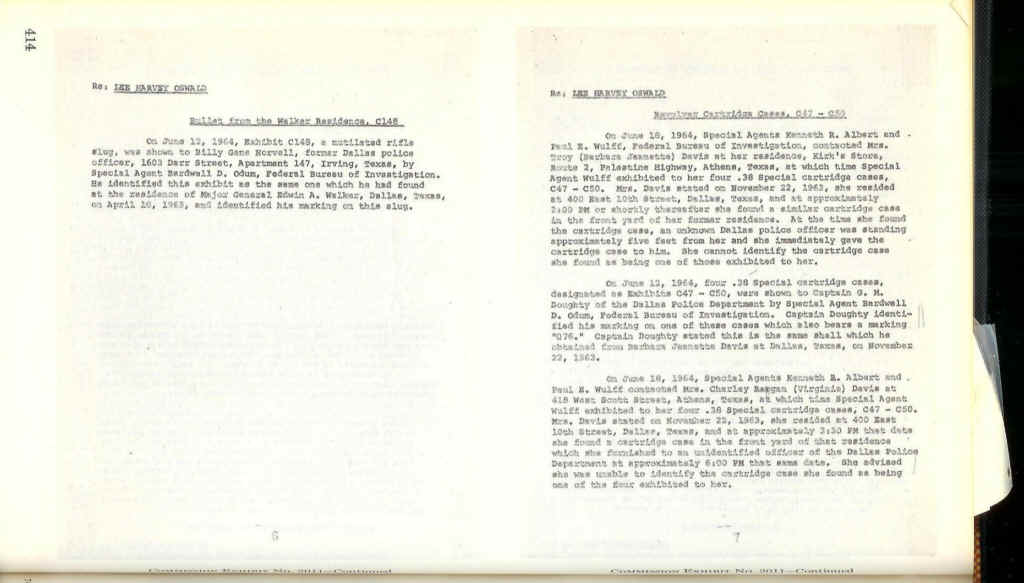
From Volume XXIV page 415
(below)
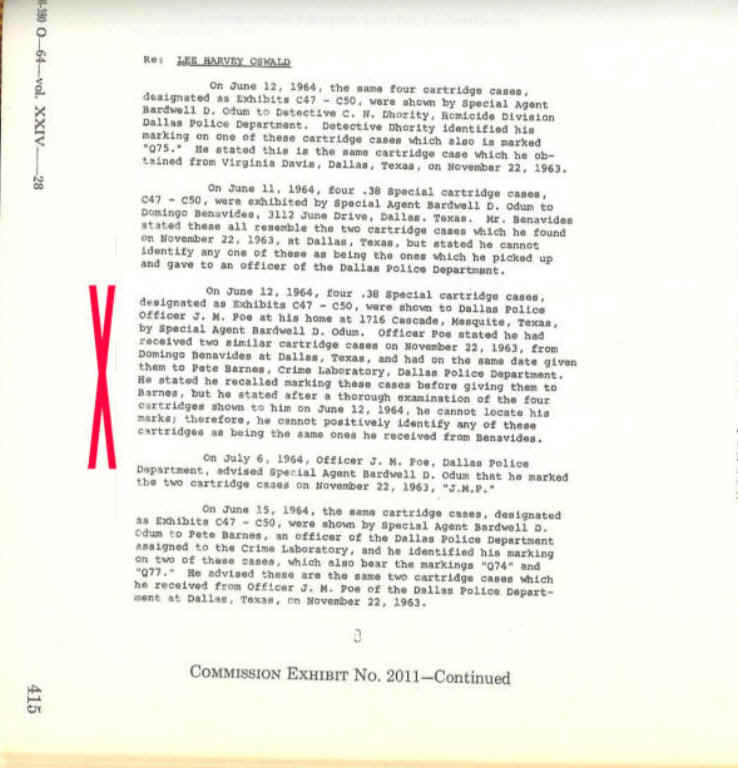
The shells recovered from the Tippit
shooting were described as coming from an "Automatic" pistol.
See DPD radio report from Volume XXI
page 296 (below)
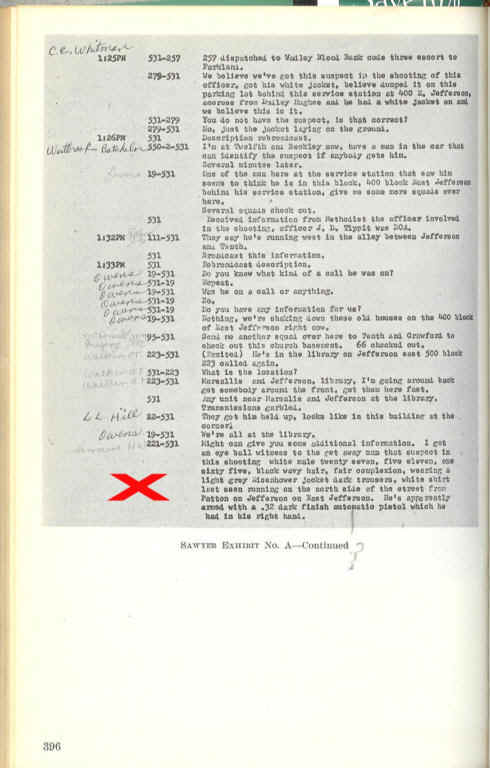
Automatic cartridge shells are
Stamped at the bottom of the shells as "AUTO".
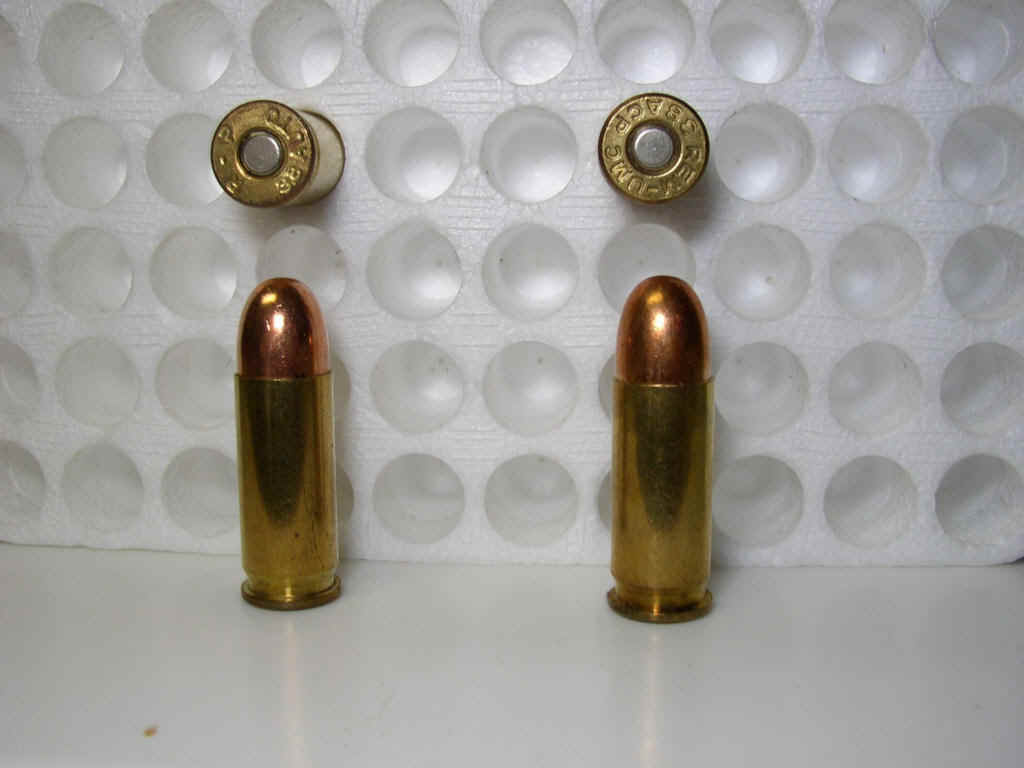
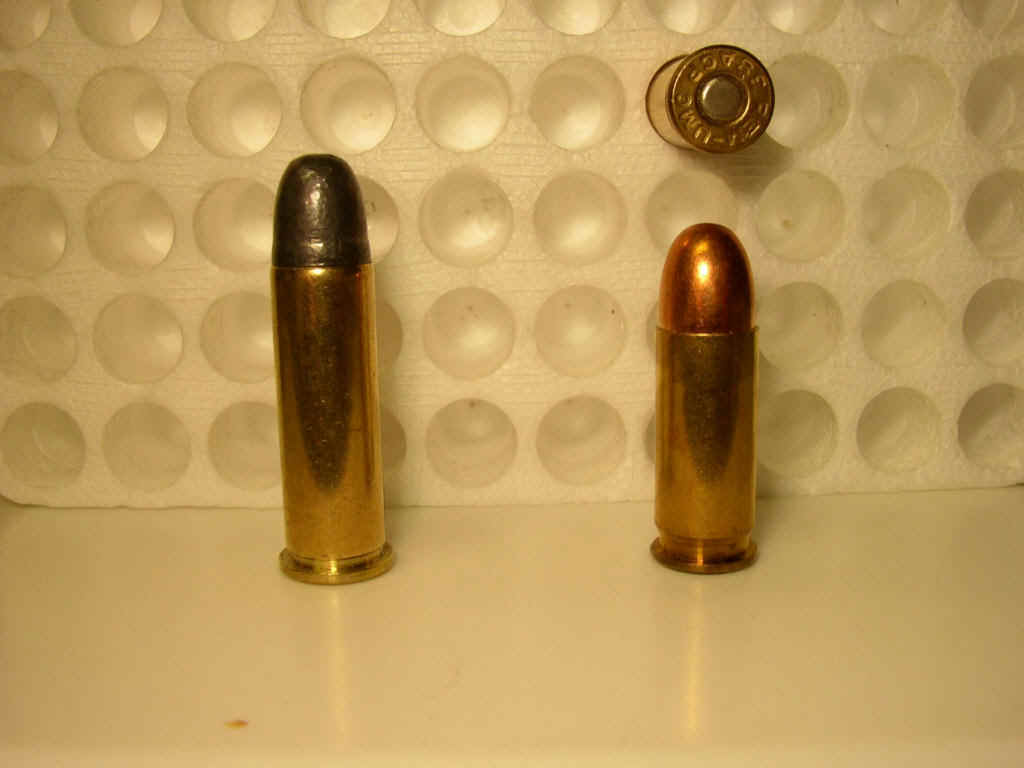
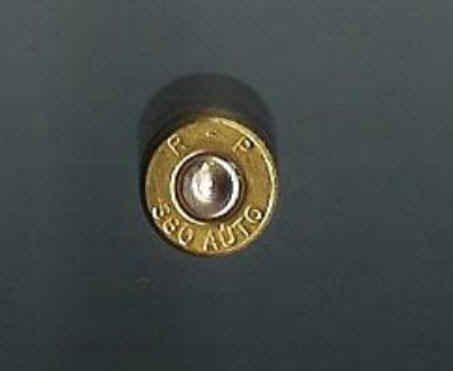 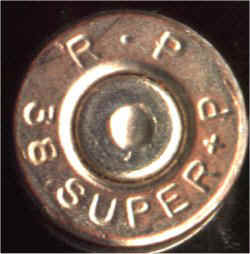
----------------------------------------------------------------------------------------------------------------------------------------------
HOUSTON, WE HAVE A PROBLEM
BADA-BING
(WR
172) States that one bullet taken from officer Tippit match Oswald's 38 "TO
THE EXCLUSION OF ALL OTHER WEAPONS"
BADA-BOOM
(WR
559) "The .38 had been RECHAMBERED for a .38 Special cartridge, it had not
been REBARRELED for a .38 Special bullet. The barrel was therefore slightly
oversized for a .38 Special bullet, which has a smaller diameter than a .38
S&W bullet. This would cause the passage of a .38 Special bullet through the
barrel to be eratic, resulting in inconsistent microscopic markings."
From
WCR page 172 below.
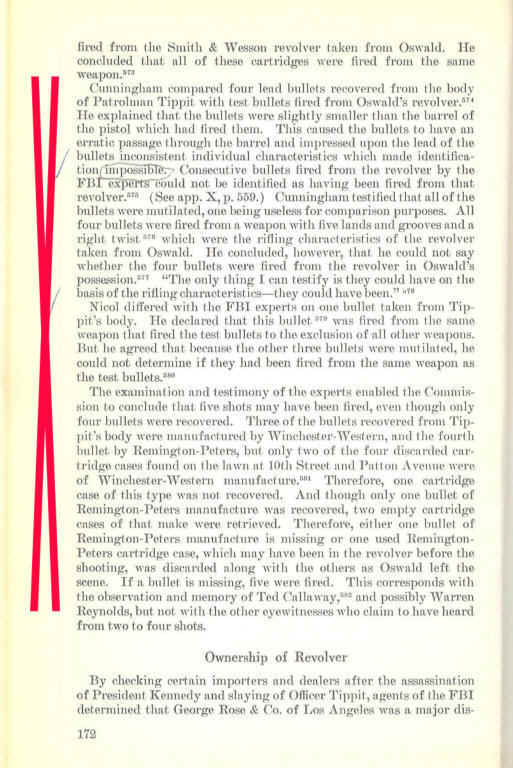
From WCR page 559. Below
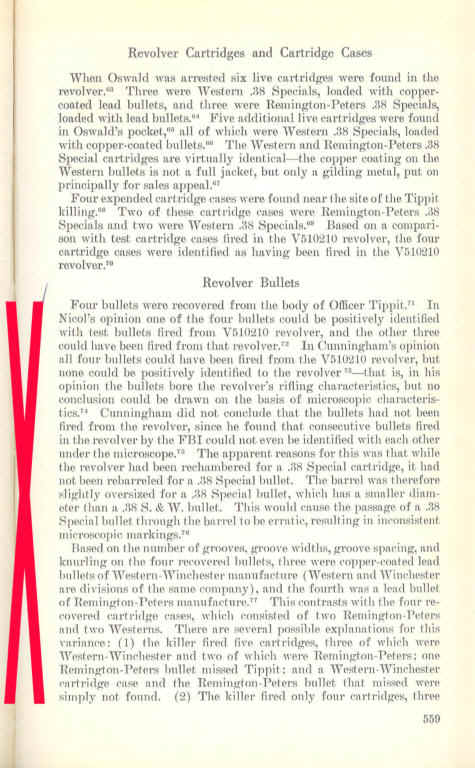


 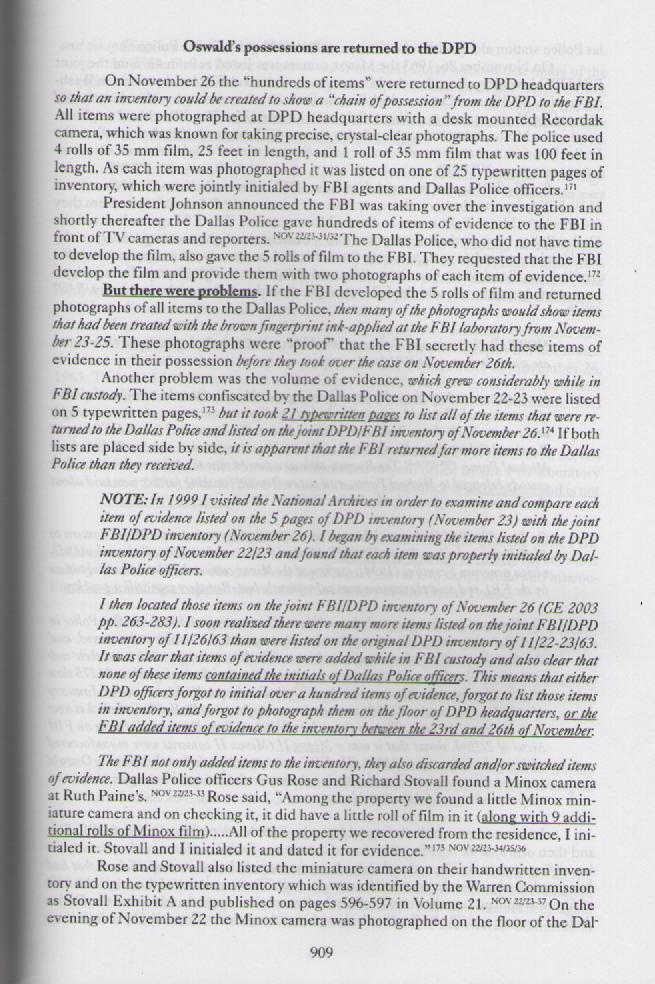
Below is from Hosty's book
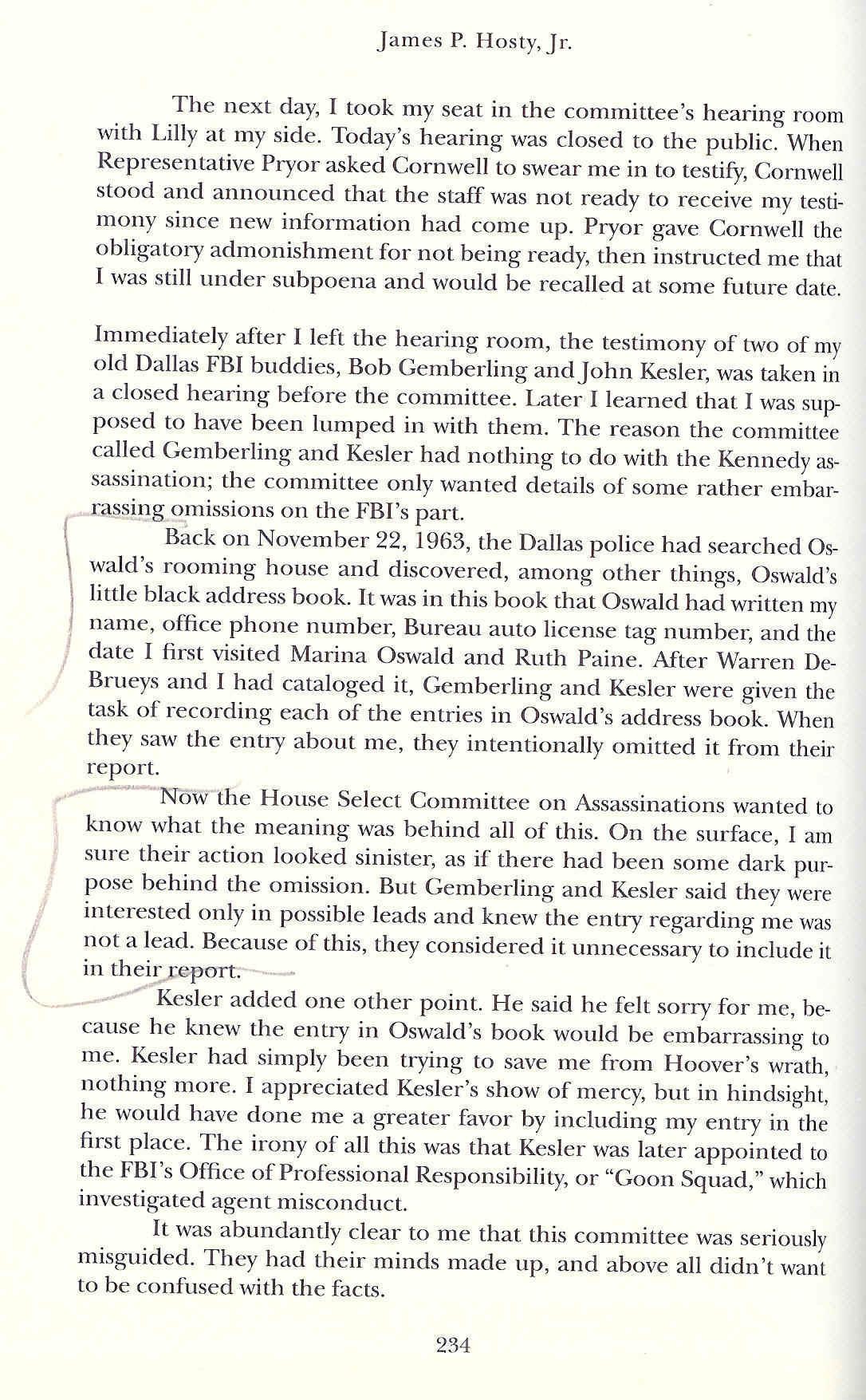
Below is from Hosty's book.
Blow is from Hosty's book

Below is a workup done by a friend who
Teaches Police at Quantico.
(8:28 PM) Bob-500: Name: Robert P. Paterniti. Firearms Ins. Contract Ins. FBI Academy Quantico, Va. from 1996 to 2005. Presently Ins. at Youngstown State U and Kent State U in the Police Basic Law Enforcement program.
(8:42 PM) Bob-500: Along with his other responsibilities at YSU he conducts inservice firearms programs of serving police officers
in combat tactics with handgun, shotgun and tactical rifle.
(9:30 PM) Bob-500: Tom! What also needs to be added. I've been A Gunsmith for over 30 years specializing in handgun modifications. (9:56 PM) Bob-500: Tom. Must dash will get that info for you and advise!!! ? Bob-500 is now offline.Messages will be delivered
when they sign on to Paltalk.
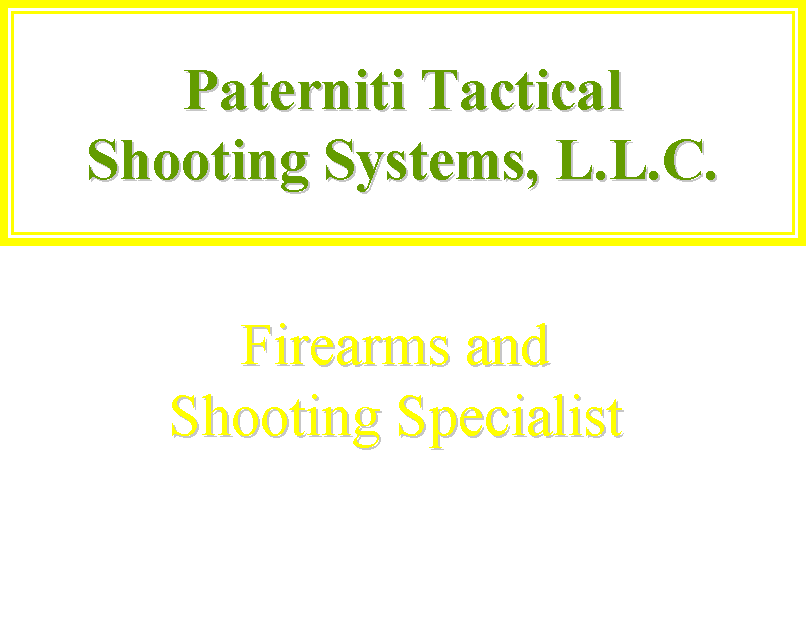
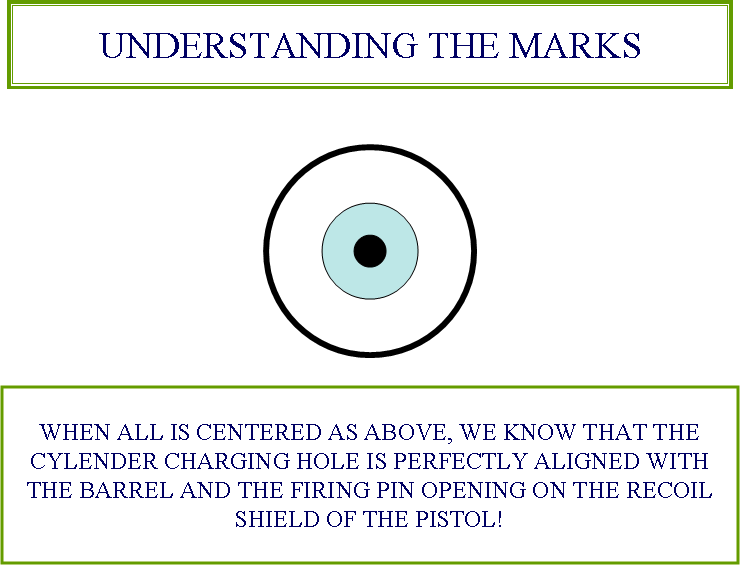
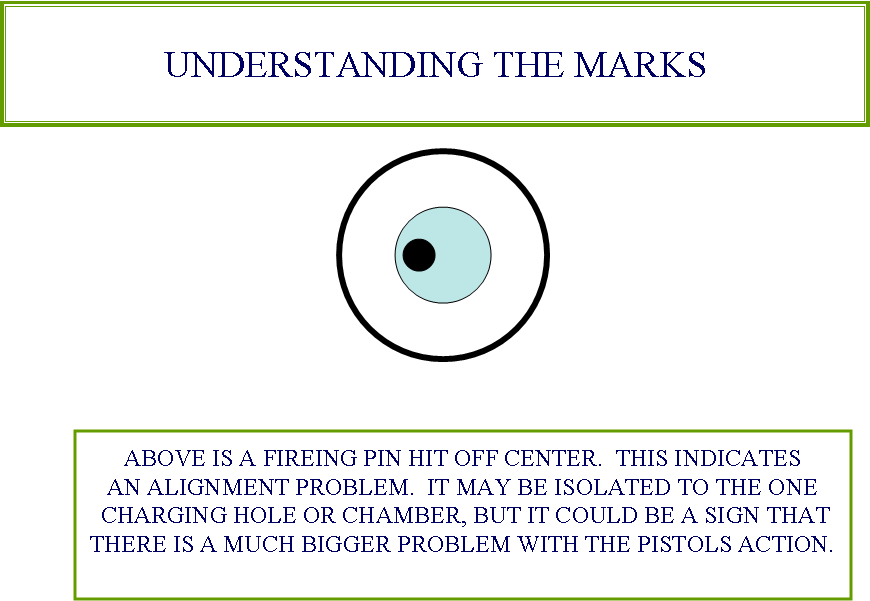
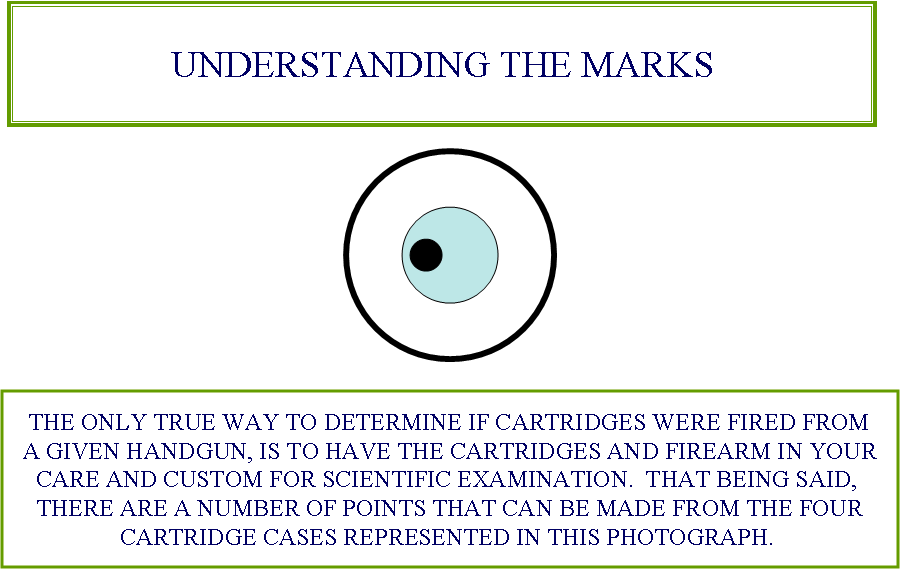
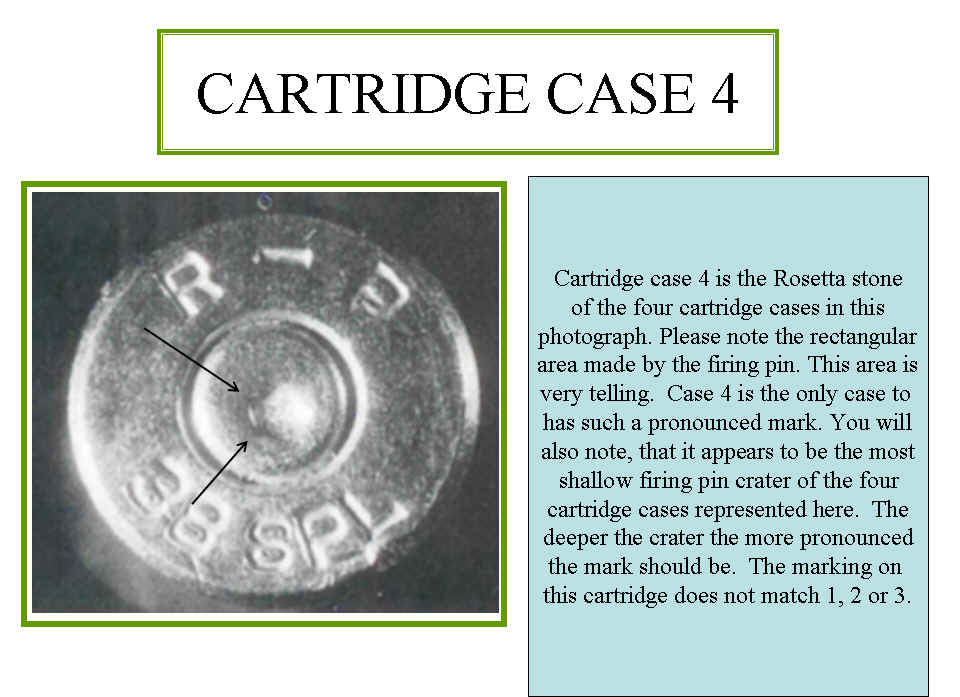
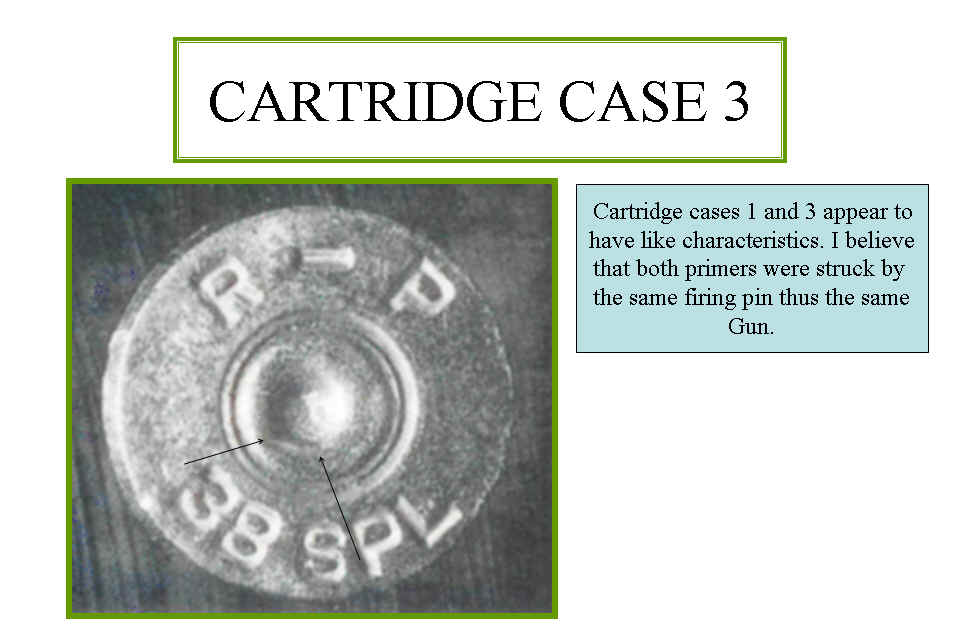
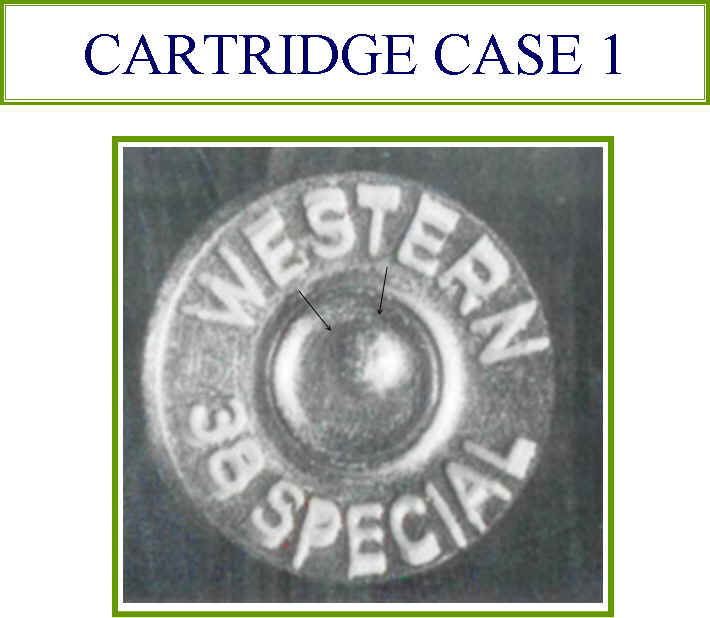
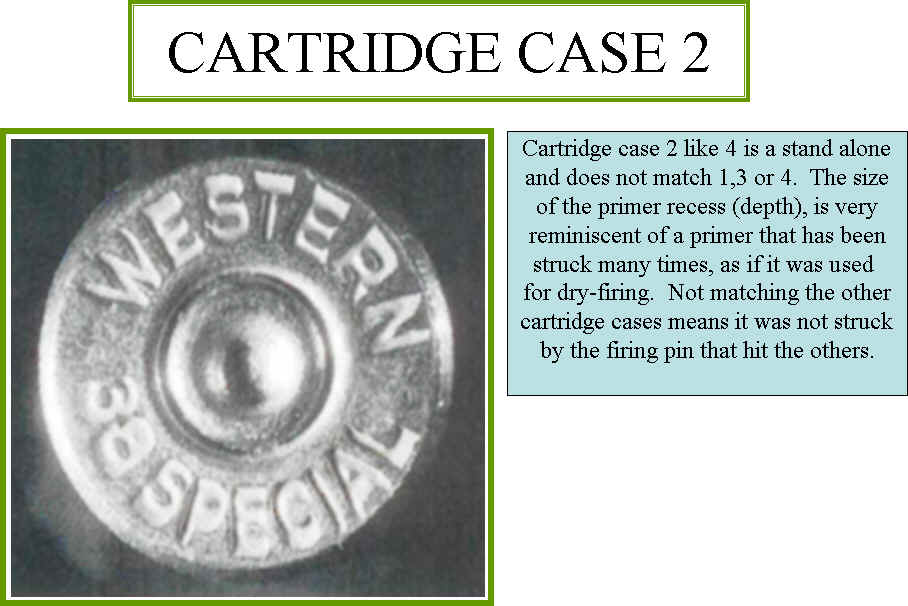
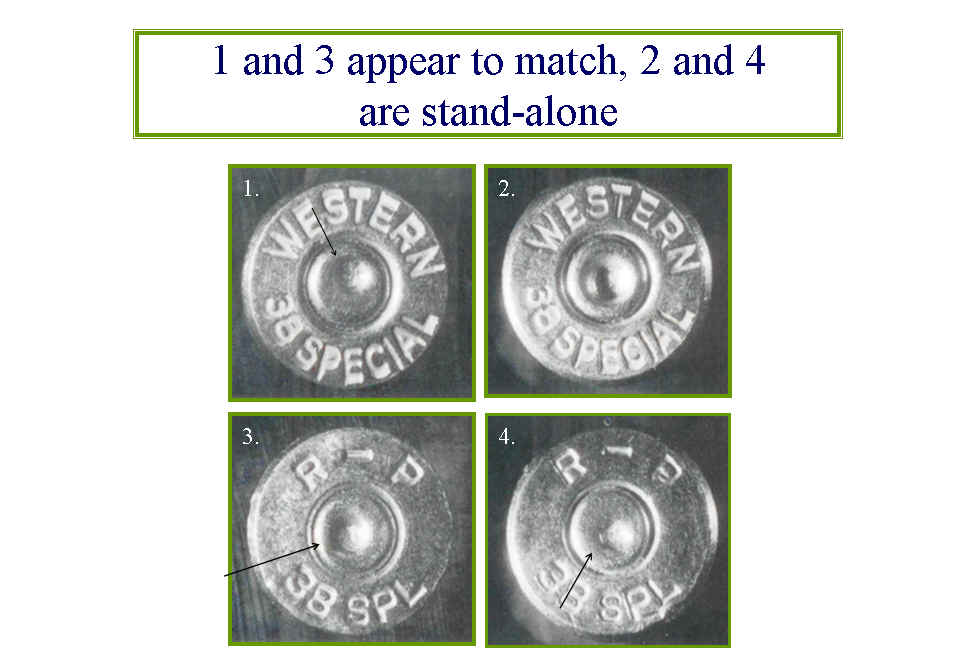
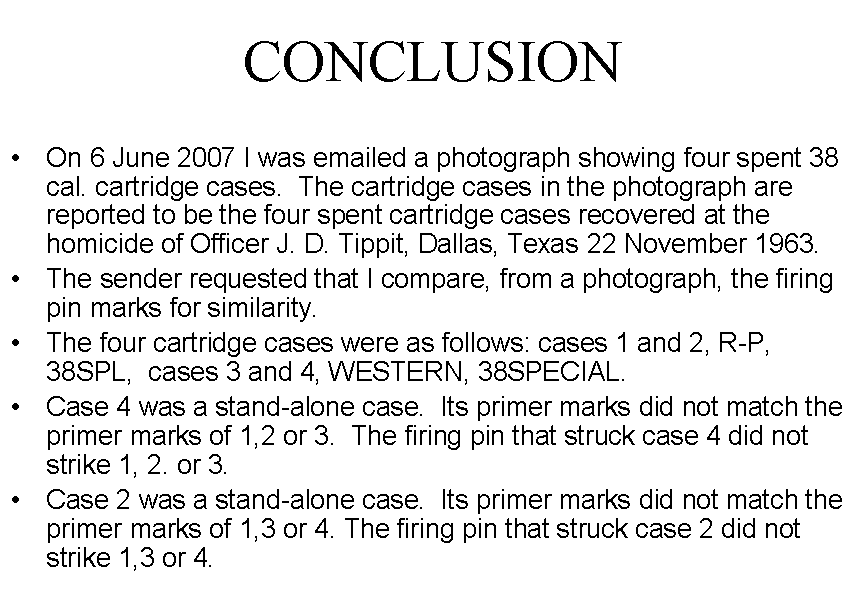
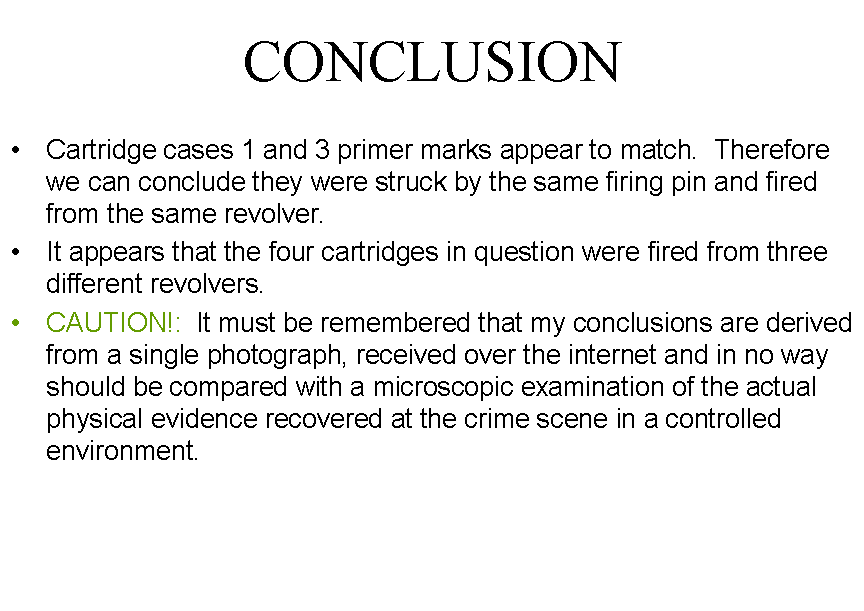
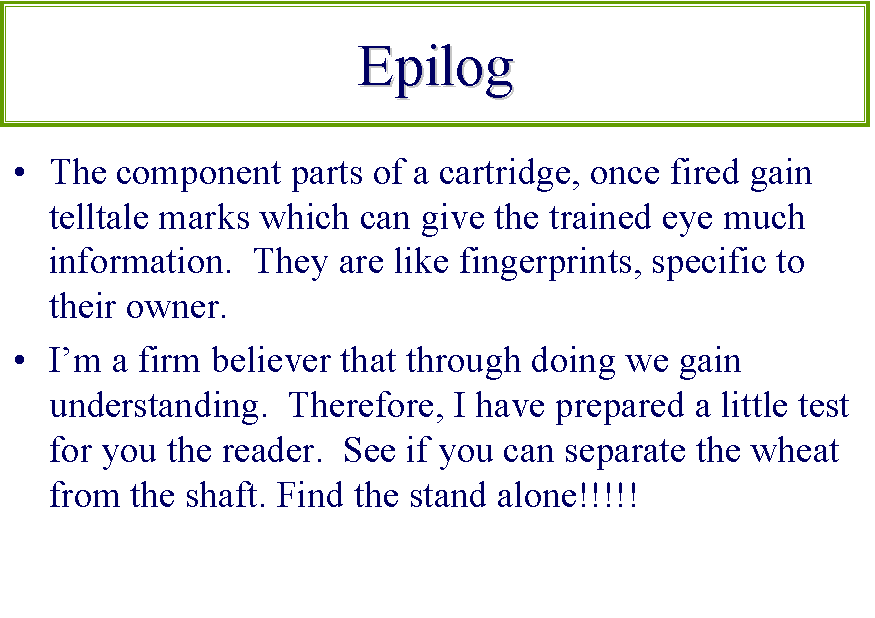
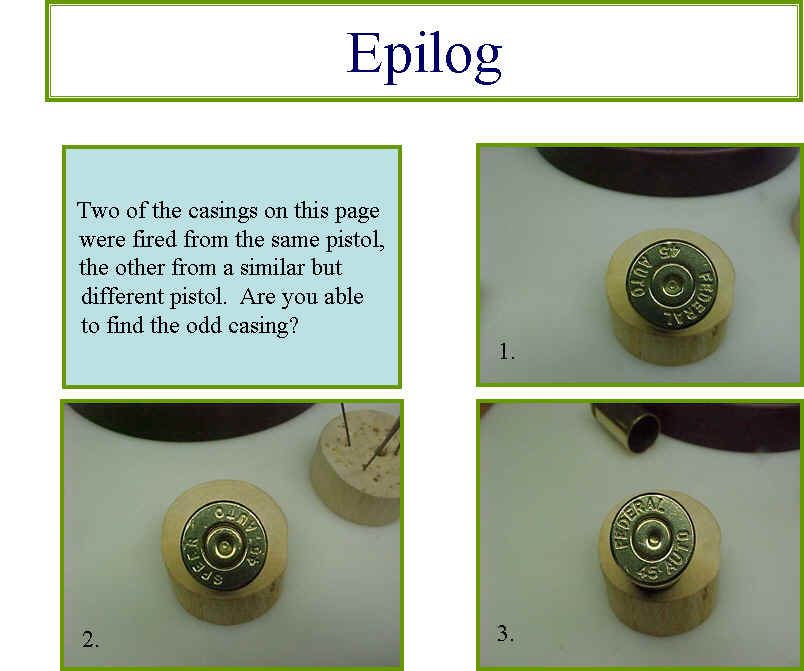
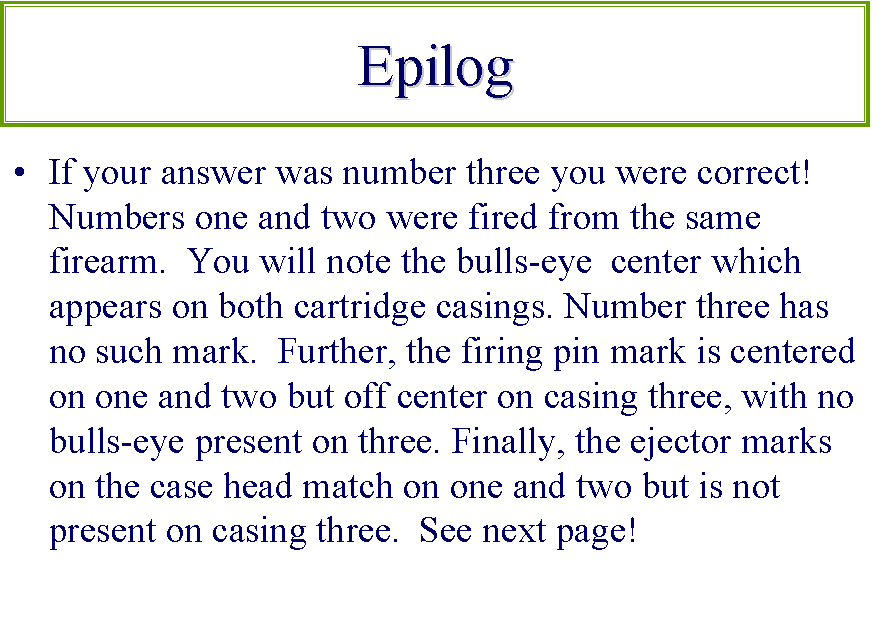
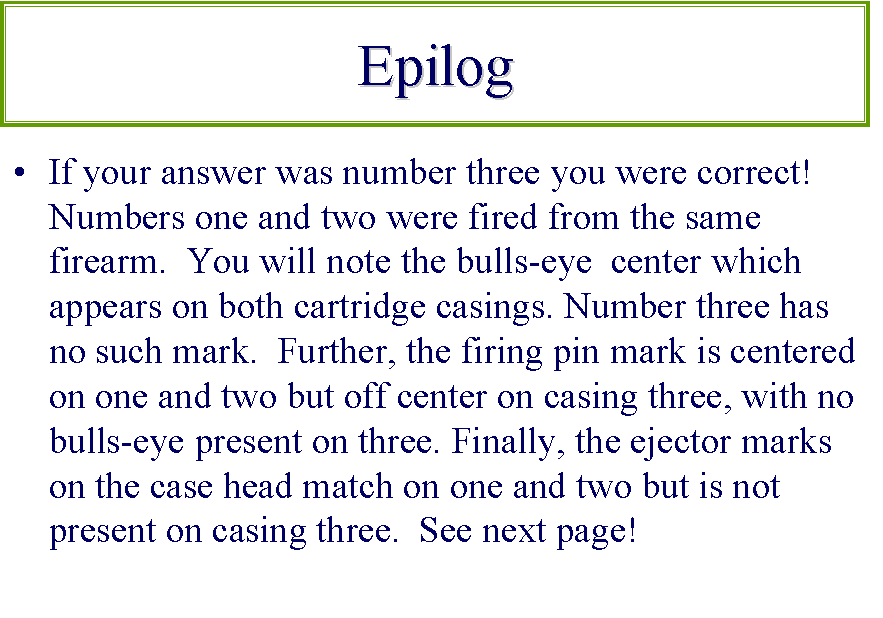
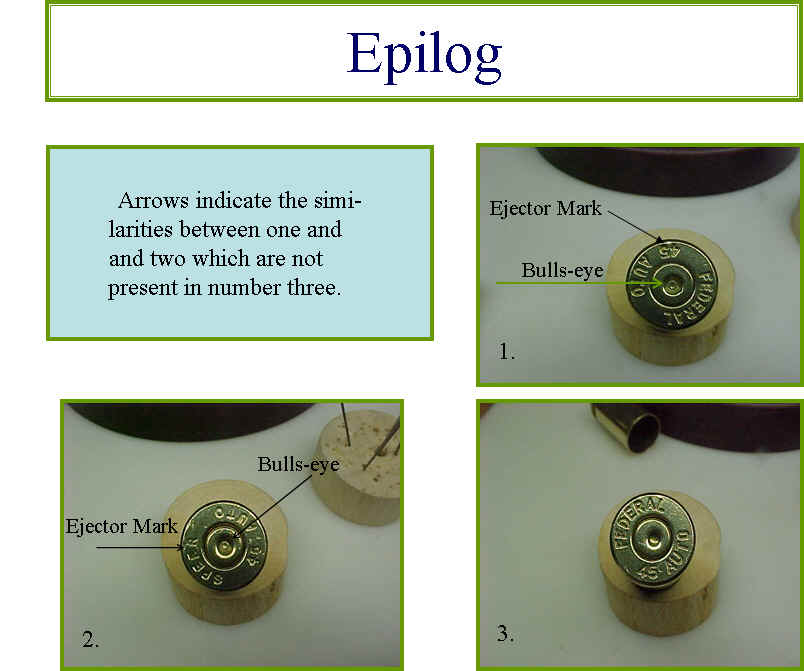
**********************************ADDENDUM*******************************************
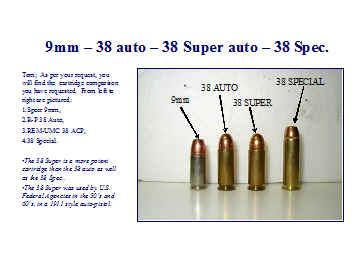 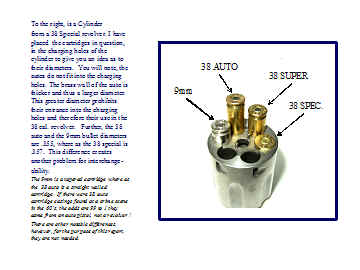
The Warren Commission tells us
that Tippit was a Devoted family man.
The DPD website lists Tippit's
family address as "238 Glencairn".
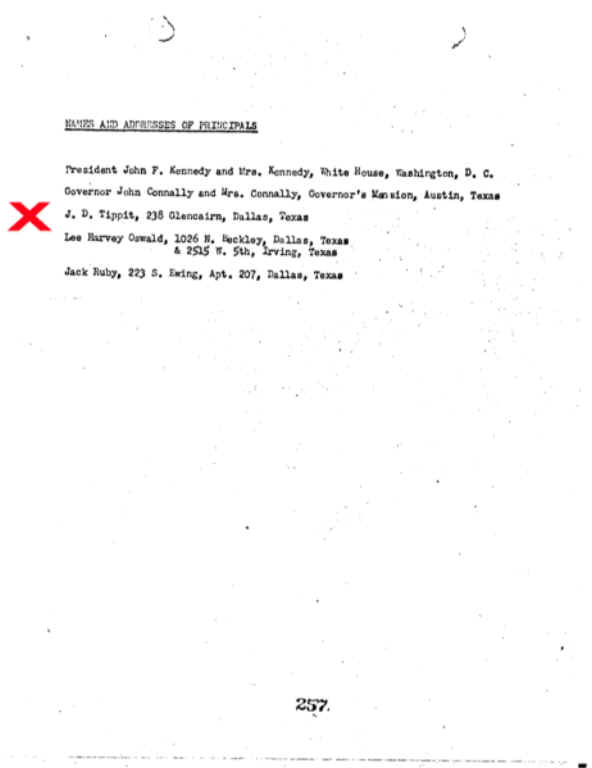
Se Robert Paterniti HERE>>> http://www.kent.edu/policeacademy/whats-new.cfm
The DPD radio log lists J D's
address as 7500 S. Beckley. (2.6 miles from Oswald)
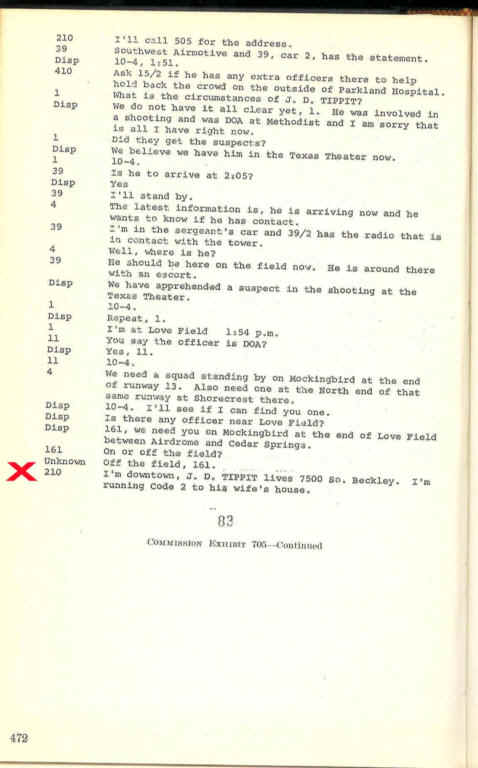
HSCA Volume XII Page 39 tells us of
Tippit having an "Affair" with Johnnie Maxie Witherspoon who worked
with Tippit at Austin's Bar-B Cue.
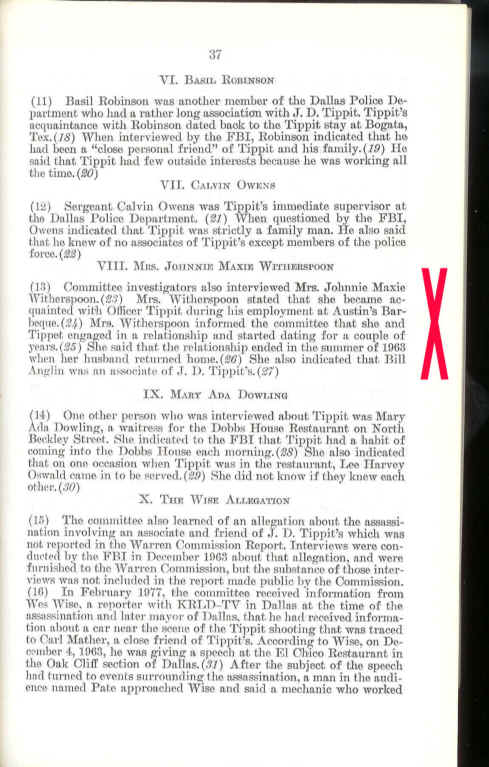
VIII. MRS. JOHNNIE MAXIE WITHERSPOON
(13) Committee investigators also interviewed Mrs. Johnnie Maxie Witherspoon.(23) Mrs. Witherspoon stated that she became acquainted with Officer Tippit during his employment at Austin's Barbecue.(24) Mrs. Witherspoon informed the committee that she and Tippet engaged in a relationship and started dating for a couple of years.(25) She said that the relationship ended in the summer of 1963 when her husband returned home.(26) She also indicated that Bill Anglin was an associate of J.D. Tippit's.(27)
*************************************************************************************************************************
Gil Jesus was kind enough to
bring this to our attention on the Newsgroup>>>
Mr. DULLES. A rumor reached me that Officer Tippit had
been some way
involved in some narcotic trouble, I don't know what the foundation
of that is. Do you know anything about that at all?
Mr. CURRY. Nothing whatsoever; no, sir.
Representative FORD. You mean you know nothing about it or you
checked it out and there is no validity?
Mr. CURRY. This is the first I ever heard of it that he was involved
in any narcotics.
( 4 H 177-178 )
Here's the Proof of Gil's Honesty from the actual
volume V page 177
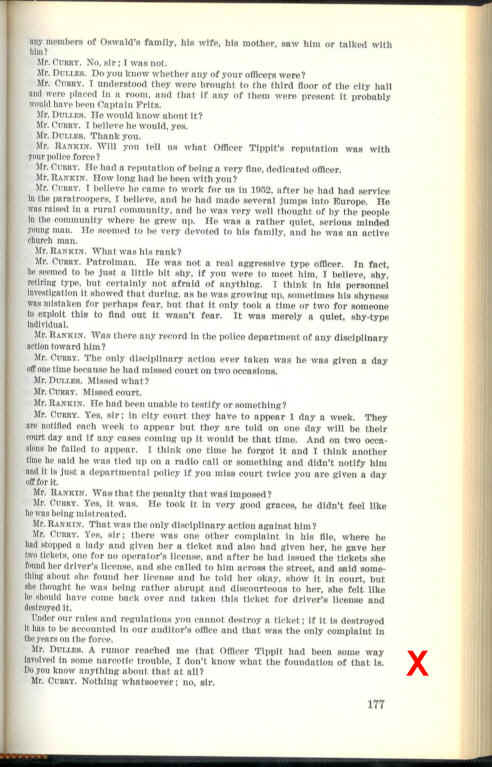
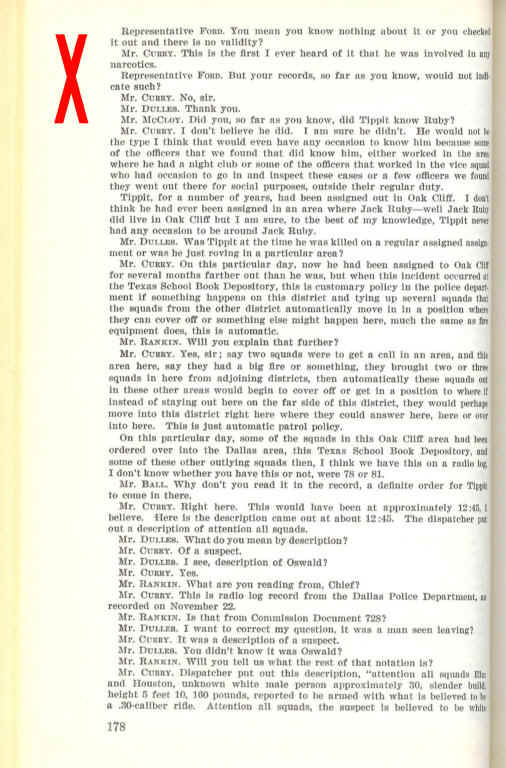
Thanks Gil
Maybe Tippit was murdered as a result of a drug
deal gone bad ! ! !
The 38 caliber bullets aledgedly taken
from Oswald's pocket appear to have "Gunbelt Residue" on
them.
Oswald was NOT known to have a Gunbelt. DPD Officers DID use
"Gunbelts".
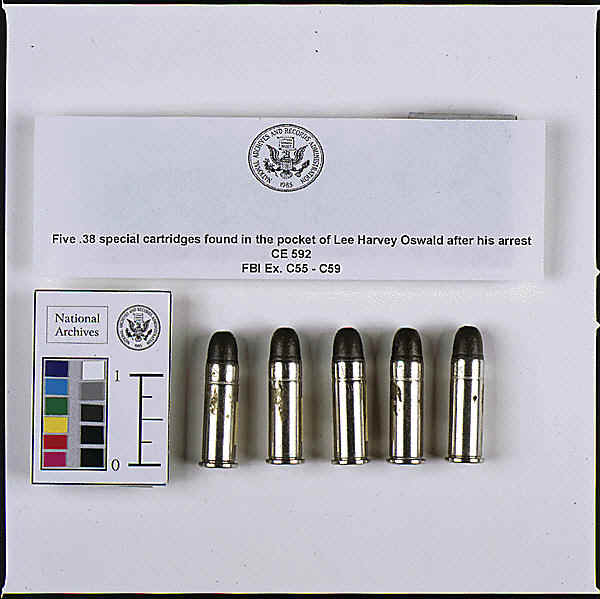
TIPPIT Mr. Higgins (witness)
|
 June
03, 2011, 04:10:03 PM June
03, 2011, 04:10:03 PM |
|
|

Super Member
    
Posts: 6262
|
Mrs. Higgins lived at 417 East 10th Street, Dallas, TX on the
22nd.
“How can you be so sure of the time?” “Well, I was watching the news on
television and for some reason the announcer turned and looked at the
clock and said the time was ‘six minutes after one,’” Mrs. Higgins
explained. “He said it just like that, ‘six minutes after one.’ And you
know how you always do, you hear the time and you automatically check
your own watch. So I just looked up at the clock on my television to
verify the time and it said 1:06. At that point I heard the shots.” “Are
you positive of the time?” “Yes, I am. I’d bet my life on it.” “Do you
know what this means then?” I persisted. Mrs. Higgins looked at her
husband and then back at me, but said nothing. She knew. “And the man
you saw running away,” I said. “What did he look like?” Mrs. Higgins got
noticeably upset and asked if I was
writing a book. I assured her I was in Dallas only to satisfy my own
curiosity. She remained quiet. “Can you describe him in any way, tell me
anything about him? Any description?” Finally, I said, “Was that man Lee
Oswald?” Mrs. Higgins stared at me, not harshly, but more like my
mother used to when she was trying to make a point. “He definitely
was not the man they showed on television,” she sighed. “Is that what
you wanted to hear?” As long as it was the truth. I thanked Mrs. Higgins
for her time and trouble. “Be careful,” she told me on my way out her
front door.
Ernest, Barry (2010). The Girl On The Stairs: My Search For A Missing
Witness To The Assassination Of John F. Kennedy (pp. 90-91). Amazon.com.
Kindle Edition.
See the following link for the web version of this article.
http://mysite.verizon.net/a1eah71/hello.htm
The transcripts of radio traffic on Channel-I and an audio file
reportedly originating from the dictabelt show that the authorities
altered the sequence of recorded events surrounding the murder of
officer Tippit.
Part One - Activity on the Primary Police Channel-I
When police initially arrived at the scene of the Tippit shooting, the
dictabelt had recorded six addresses for the location of the crime
scene. This situation is particularly difficult to dismiss since a
citizen reported the shooting to the police over the two-way radio of
Tippit's patrol car.
http://mysite.verizon.net/a1eah71/hello_files/citizen.wav
They reported the location as Tenth Street, between Marsalis and
Beckley at 404 Tenth Street.
http://jfk.ci.dallas.tx.us/04/0476-001.gif
On December 2, 1963, T. F. Bowley filed an affidavit that asserts he
radioed the report of a shot officer to the police. However, he quoted
himself as having said, "A police officer has been shot here." These
words differed from the dictabelt that recorded the words, "We've had
a shooting out here." So I decline to identify Bowley as the citizen
who reported the first address of 404 Tenth Street.
Two dispatchers worked Channel-I. Murray James Jackson dispatched
calls that come over the radio while C. E. Hulse handled calls that
come through the police telephone lines. Each dispatcher had a speaker
and heard all activity recorded by the Dictaphone excepting their own
words. So a dispatcher could have missed a message broadcast
simultaneously with their own words. However, the other dispatcher
would have heard the simultaneous broadcasts and could have used the
conveyor belt to send a written message to their counterpart.
A dispatcher began speaking while the citizen said, "Hello police
operator did you get that?" After the citizen stopped speaking, he
heard "a police officer 510 East Jefferson."
http://mysite.verizon.net/a1eah71/hello_files/tippit00250028.wav
The citizen waited for completion of the message then instead of
repeating his request for confirmation, he replied "thank you" as if
there were no communications gap.
At this point the police had two addresses for the shooting.
http://mysite.verizon.net/a1eah71/hello_files/tippit00360037.wav
Nevertheless A. R. Brock of unit 69 announced "Vince and I are going
out there."
http://mysite.verizon.net/a1eah71/hello_files/tippit00440045.wav
Shortly afterwards Ray Hawkins and E. R. Baggett of unit 211 informed
the dispatcher, "We're clear at Industrial and Stemmons. We'll go out
there." Neither unit asked whether they were going to 404 Tenth Street
or 510 East Jefferson.
http://mysite.verizon.net/a1eah71/hello_files/tippit00550057.wav
The first mention of 501 East Tenth Street occurred when the
dispatcher responded to a station that asked "What's that address on
Jefferson?" The station had cause to ask because 510 East Jefferson
was mentioned earlier in relation to a police officer. By contrast,
the dispatcher who conversed with the citizen had no cause to send the
ambulance to the address of Frank and Mary Wright.
http://mysite.verizon.net/a1eah71/hello_files/tippit00610063.wav
Sergeant Calvin Bud Owens gave the dispatcher another opportunity to
acknowledge the address of 404 Tenth Street. Owens said, "Give me the
correct address on the shooting." The dispatcher failed to
acknowledge the earlier addresses of 404 Tenth Street or 510 East
Jefferson and the dispatcher reaffirmed the third address of the
shooting as 501 East Tenth Street.
A dispatcher introduced a fourth address by stating, "We have two
locations 501 East Jefferson and 501 East Ten." This former address
belonged to the Harris Motor Company that employed Ted Callaway and
Sam Guinyard.
http://mysite.verizon.net/a1eah71/hello_files/callaway.wav
A second citizen used the police radio and reported that the shot
officer was on the 500 block of Tenth Street. Spectators who gave the
earlier citizen the number of the police car and the street address of
the shooting did not correct this error. In fact background voices
were not heard during this report. The dispatcher accepted this fifth
address and told the second citizen we have that information.
http://history-matters.com/archive/jfk/wc/wcvols/wh3/html/WC_Vol3_0181b.htm
In his Warren Commission testimony, Ted Callaway reported using the
police radio and gave sufficient details to identify himself as the
second citizen.
A question by Captain Cecil E. Talbert confirmed that at least one
citizen radioed a report of the shooting. The dispatcher asked, "Did
you receive the information on the police officer shot?" Talbert said,
"But didn't that citizen say first he was on Jefferson, then on Tenth
and then Chesepeak?" The spelling of the last named location is
questionable. A locally prepared transcript of Sawyer Exhibit A
spelled the last named location as Chesepeak. CE-705, prepared by the
FBI, spelled the location as Chesapeak while the CE-1974 also prepared
by the FBI spelled the name as Chesapeake.
A dispatcher announced the indirect report of the shooting by Barbara
Jeanette Davis approximately three and a quarter minutes after
receiving the address as 404 Tenth Street. He said " . . . have a
signal 19 involving a police officer 400 East Ten."
Part Two - Activity on Channel-II
Although the primary police channel was clogged with six addresses
pertaining to the shooting, the transcripts of Channel-II reported two
addresses.
http://history-matters.com/archive/jfk/wc/wcvols/wh21/html/WH_Vol21_0212b.htm
Sawyer Exhibit B of December 5, 1963 described two messages pertaining
to a shot officer. The first message informed all squads of an officer
involved in a shooting in the 400 block of East Tenth. The second
message requested informing Chief Curry of an officer involved in a
shooting of unknown seriousness at Tenth and Patton.
http://history-matters.com/archive/jfk/wc/wcvols/wh17/html/WH_Vol17_0247b.htm
http://history-matters.com/archive/jfk/wc/wcvols/wh23/html/WH_Vol23_0477a.htm
CE 705 and CE 1974 included a disjointed message. The dispatcher,
Gerald Dalton Henslee, told Sergeant Owens, "It's in the 400 or 500
block of E. 10th, I believe." Owens responded but neither transcript
reported him asking for the correct address on Channel-II.
During the afternoon of November 22, 1963, Henslee played a dual role
in the dispatcher's office. He supervised incoming radio calls on
Channel-I and was the sole dispatcher for Channel-II. These duties
exposed him to the radioed messages from the two citizens who reported
the 400 block and the 500 block of East Tenth Street as the location
of the shot officer. So the sources of the information that Henslee
relayed to Owens were not necessarily the telephonic messages from 400
East Tenth or 501 East Tenth. The failure of Henslee to mention the
501 East Jefferson address of the Harris Motor Company or the 510 East
Jefferson address of the Reynolds Motor Company suggest that the
reports radioed by citizens were the sources of the information
relayed to Owens.
Part Three - Knowledge of the Callers
http://jfk.ci.dallas.tx.us/04/0447-001.gif
The affidavit of Barbara Jeanette Davis dated November 22, 1963 states
that she heard shots, went to the door, saw a man unloading a gun
while walking across her yard and heard a woman screaming that "he
shot him, he killed him." She ran into the house and reported this
information to the telephone operator.
http://jfk.ci.dallas.tx.us/04/0448-001.gif
Mrs. Charlie Virginia Davis corroborated this call to the authorities
in her affidavit of November 22, 1963. These documents justify the
dispatcher's broadcast, "signal 19 involving a police officer 400 East
Ten."
http://jfk.ci.dallas.tx.us/04/0452-001.gif
http://jfk.ci.dallas.tx.us/04/0482-001.gif
According to the affidavits of Ted Callaway and Sam Guinyard dated
November 22, 1963 neither witness called the police before going to
the scene of the shooting. Although not mentioned in his affidavit, it
appears that Callaway radioed the police. This radio report shows
that police had not yet arrived at the crime scene. So an undocumented
conversion with the police could not have been source of the
dispatcher's knowledge of the 501 East Jefferson business address of
Callaway. Although these circumstances allow an unidentified person of
the Harris Motor Company to have telephoned the police, the expected
contents of a call that reported gun shots and a running man carrying
a weapon cannot justify the dispatcher placing as much weight upon the
501 East Jefferson address as the address of the shot officer reported
from Tippit's patrol car.
Frank and Mary Wright of 501 East Tenth Street were among the ghost
witnesses at the Tippit crime scene. The Dallas Municipal Archives
that inherited the voluminous holdings of the Dallas Police Department
contains no affidavits from these witnesses. A search of the FBI files
uncovered no interviews of Wrights. Apparently the authorities found
the knowledge of Frank or Mary Wright was unworthy of report.
The address of 510 East Jefferson belonged to the business office of
the Reynolds Motor Company. From this location and the adjacent used
car lot at 500 East Jefferson four troublesome witnesses raised a
timing problem that the authorities needed to conceal.
http://history-matters.com/archive/jfk/wc/wcvols/wh20/html/WH_Vol20_0277b.htm
In particular the FBI interview of L. J. Lewis on January 21, 1964
discloses that he learned of the shot officer after calling the police
to report hearing gun shots and seeing a running man carrying an
automatic pistol or a revolver.
http://history-matters.com/archive/jfk/wc/wcvols/wh21/html/WH_Vol21_0204a.htm
Harold Russell in his FBI interview of January 21, 1964 corroborated
Lewis on this timing issue. This interview stated, Russell advised
that he and Pat Patterson went to the vicinity of Tenth and Patton
while L. J. Lewis went into the business office and called the police.
Upon arriving at the scene of the shooting, Russell observed an
apparently dead police officer.
http://history-matters.com/archive/jfk/wc/wcvols/wh21/html/WH_Vol21_0025a.htm
The FBI interview of B. M. Patterson on January 22, 1964 states that
he heard shots at approximately 1:30 PM. A minute or so later he
observed a running man carrying a revolver. Being unaware that the
observed man had shot a police officer, Warren Reynolds suggested that
they follow the individual and later notify the police.
http://history-matters.com/archive/jfk/wc/wcvols/wh25/html/WC_Vol25_0381a.htm
Warren Reynolds in the FBI interview of January 21, 1964 stated that
he heard shots during the afternoon then observed a running individual
with a pistol or an automatic. He followed from a safe distance and
last observed the man by the Ballew Texaco Service Station. Reynolds
advised approximately five or ten minutes later someone told him that
the man he had been "tailing" had shot and apparently killed an
officer. Reynolds hesitated to definitely identify the person that he
followed on the afternoon of November 22, 1963 as the same person in a
photograph of Lee Harvey Oswald. Although the FBI interviews of
January 1964 reported that B. M. Patterson and Harold Russell
positively identified the running man carrying a gun as Lee Harvey
Oswald the Dallas authorities produced no records of interviews or
affidavits from these pivotal witnesses. The Warren Commission
foregone corroborated testimonies that positively placed Lee Harvey
Oswald fleeing the scene of the Tippit shooting in favor of affidavits
that affirmed the FBI interviews of January 1964.
http://jfk.ci.dallas.tx.us/10/1007-001.gif
Warren Reynolds filed a belated affidavit on March 16, 1964. Reynolds
stated that shortly after noon he heard one shot followed by four or
five other shots. He looked out the window and saw a running man
waving a pistol who he now knows as Lee Harvey Oswald. Reynolds
followed Oswald until losing sight of him at the Texaco station.
During August the Warren Commission renewed their interest in the
witnesses associated with the Reynolds Motor Company.
http://history-matters.com/archive/jfk/wc/wcvols/wh7/html/WC_Vol7_0301b.htm
On August 10, 1964, an affidavit of Harold Russell affirmed the FBI
report of his interview during the previous January.
http://history-matters.com/archive/jfk/wc/wcvols/wh21/html/WH_Vol21_0025b.htm
By request of the Warren Commission, the FBI contacted L. J. Lewis and
B. M. Patterson to determine the accuracy of their interviews of last
January.
http://history-matters.com/archive/jfk/wc/wcvols/wh15/html/WC_Vol15_0357a.htm
On August 26, 1964, L. J. Lewis executed an affidavit that placed his
call to the police after hearing the shots and a few minutes before
seeing the running man. He stated that there was so much confusion at
the Police Department that they having trouble making out what I was
telling them.
http://history-matters.com/archive/jfk/wc/wcvols/wh15/html/WC_Vol15_0377b.htm
The affidavit of B. M. Patterson on August 26, 1964 revised the FBI
report of his interview during January of the same year. Patterson
doubted having been shown a photograph of Lee Harvey Oswald in
January.
http://history-matters.com/archive/jfk/wc/wcvols/wh15/html/WC_Vol15_0378a.htm
On September 7, 1964, B. M. Patterson executed an affidavit that
affirmed the written reports on his interviews of August 25 and 26,
1964 by Special Agent Richard J. Burnett of the FBI.
The testimonies and interviews of Patterson, Reynolds and Russell
corroborated Lewis on his claimed ignorance of a shot officer when he
phoned the police from 510 East Jefferson.
Part Four Mutations of the Channel-I Radio Transcripts
The Warren Commission published three versions of the words that
followed the citizen's question, "Did you get that?"
http://history-matters.com/archive/jfk/wc/wcvols/wh21/html/WH_Vol21_0210a.htm
Sawyer Exhibit A of December 3, 1963, reported that the dispatcher who
conversed with the citizen broadcast the words, "Signal 19 involving a
police officer, 510 E. Jefferson."
http://history-matters.com/archive/jfk/wc/wcvols/wh17/html/WH_Vol17_0217b.htm
A transcript produced three months later and became CE 705 attributed
the evolving message to an unknown voice who said "a police officer,
510 E. Jefferson." During August of 1964 the third version attempted
to reconcile the contradictory reports of the previous two
transcripts. They attributed the statement, "a police officer, 510
East Jefferson" to the citizen that was repeated by the Dispatcher as
"Signal 19, involving a police officer, 510 East Jefferson."
http://history-matters.com/archive/jfk/wc/wcvols/wh23/html/WH_Vol23_0445b.htm
The Warren Commission published this transcript within CE 1974
The citizen said seven words, "Hello police operator did you get
that?" during the interval that CE 1974 claimed the dispatcher said
the three words, "Signal 19, involving." However, both messages began
simultaneously so the claim of CE 1974 strongly suggests that they
transcribed a mutated record of the dictabelt.
Part Five - Signal Analyzes of the Radioed Reports of the Shooting
Each dispatcher had a telephone link that bypassed the main police
radio receiver and feed directly into the main transmitter. These
links impressed distinguishing characteristics upon all broadcasts by
the dispatches. The main radio receiver added a noise burst at the end
of a non simultaneous reception. Broadcasts from the each dispatcher
lacked these bursts of noise.
Three radio events surrounding the report by the citizen merit special
attention. The citizen made a brief broadcast and gave the location as
tenth street.
http://mysite.verizon.net/a1eah71/hello_files/tippit0009.wav
A second burst of noise followed the expected burst of the receiver.
An innocent explanation of this reception required that a mobile
station interrupted a report of shooting by keying in at end of the
citizen's cryptic reply, said nothing, keyed out and produced the
second noise burst. Since these circumstances, not matter how
improbable, are physically possible the double burst of noise is
evidence, not proof, of an altered tape of a dictabelt.
http://mysite.verizon.net/a1eah71/hello_files/tippit00240025.wav
The presence of a noise burst following the simultaneous recording of
two messages proves that the citizen asked, "Police operator did you
get that?" and the dispatcher said, "a police officer, 510 East
Jefferson." Without doubt, this noise burst discredits the attempts of
CE 705 and CE 1974 to attribute this second address to an unknown
person or the citizen.
http://mysite.verizon.net/a1eah71/hello_files/tippit00260027.wav
About 0.5 second after the dispatcher said, "a police officer, 510
East Jefferson" a mobile station keyed in, broadcasted background
voices for 0.7 second, keyed out and produced a noise burst. So the
audio record of the citizen's report of the shooting of Tippit
contained another highly improbable event. In this case a mobile
station interrupted a report of a shot officer and said nothing.
http://mysite.verizon.net/a1eah71/hello_files/tippit00910092.wav
Ted Callaway began his report by saying "Hello, hello, hello" and then
paused to listen. The noise burst that followed Callaway's words shows
that he was the only transmitting unit on the channel.
http://mysite.verizon.net/a1eah71/hello_files/callaway0002sub1.wav
Almost immediately an ambulance announced its 602 call number. An
analysis of the signal revealed excessive frequency deviation of the
transmitter and a heterodyne impaired intelligibility of the message.
Shortly after their last number, the operator released the transmit
button.
http://mysite.verizon.net/a1eah71/hello_files/callaway0002sub2.wav
A radio receiver responded to the absence of a signal by producing a
quarter second noise burst. During this burst the operator's
transmitter was off so the excessive deviation had no degrading
effects upon the noise burst. However, my audio file recorded a noise
burst distorted by a heterodyne. Since generation of the heterodyne
required reception of two radio signals and production of the noise
burst demanded absence of any radio signal, the distorted noise burst
is proof of an unprofessional alteration of my audio record of the
dictabelt.
|
TIPPITMr. Higgins
|
 June
03, 2011, 04:10:03 PM June
03, 2011, 04:10:03 PM |
|
|

Super Member
    
Posts: 6262
|
Mrs. Higgins lived at 417
East 10th Street, Dallas, TX on the 22nd.
“How can you be so sure of the time?” “Well, I was watching the news on
television and for some reason the announcer turned and looked at the
clock and said the time was ‘six minutes after one,’” Mrs. Higgins
explained. “He said it just like that, ‘six minutes after one.’ And you
know how you always do, you hear the time and you automatically check
your own watch. So I just looked up at the clock on my television to
verify the time and it said 1:06. At that point I heard the shots.” “Are
you positive of the time?” “Yes, I am. I’d bet my life on it.” “Do you
know what this means then?” I persisted. Mrs. Higgins looked at her
husband and then back at me, but said nothing. She knew. “And the man
you saw running away,” I said. “What did he look like?” Mrs. Higgins got
noticeably upset and asked if I was
writing a book. I assured her I was in Dallas only to satisfy my own
curiosity. She remained quiet. “Can you describe him in any way, tell me
anything about him? Any description?” Finally, I said, “Was that man Lee
Oswald?” Mrs. Higgins stared at me, not harshly, but more like my
mother used to when she was trying to make a point. “He definitely
was not the man they showed on television,” she sighed. “Is that what
you wanted to hear?” As long as it was the truth. I thanked Mrs. Higgins
for her time and trouble. “Be careful,” she told me on my way out her
front door.
Ernest, Barry (2010). The Girl On The Stairs: My Search For A Missing
Witness To The Assassination Of John F. Kennedy (pp. 90-91). Amazon.com.
Kindle Edition.
|
Another tidbit I just found on Aug,29,2012 (below)
Judyth Vary Baker
|
|
|
Judyth Baker |
|
Judyth Baker
updated her status: "THE FRAMING
OF LEE HARVEY OSWALD: TWO
WALLETS INCIDENT: (source:
Armstrong and Hargis) "The
Warren Commission told us the
police learned Oswald's identity
while en route to the police
station after his arrest.
Detective Paul Bentley removed
Oswald's wallet from his left
rear pocket and found
identification for Lee Oswald
and Alik Hidell. (slide, RIGHT
35) But they did not tell us
that a DPD officer identified
Oswald, by name, to [theater
ticket seller] Julia Postal as
they took Oswald out the front
of the theater. This was before
Oswald was placed in the police
car and before Officer Bentley
removed Oswald's wallet from his
left rear pocket. They knew
Oswald's name before they even
entered the theater, from
identification found in the
wallet left at the Tippit murder
scene." "Researcher Jones Harris
interviewed Julia Postal in
1963. When Harris asked Julia
Postal if she had sold a ticket
to "Oswald" (the man arrested),
she burst into tears and left
the room. A short time later
Harris again asked Postal if she
sold a ticket to "Oswald" and
got the same response. From
Postal's refusal to answer this
question and her reaction to
same, Harris believes that
Postal did sell "Oswald" a
theater ticket. On February 29,
1964 Postal told FBI Agent
Arthur Carter "she was unable to
recall whether or not he bought
a ticket." (A few months later,
when the Warren Report was
issued, Postal's memory had
improved. She was now certain
the man did not buy a ticket.
See page 178 of the report.)" [JVB:
but we know the Warren
Commission and FBI sometimes
altered testimonies; sometimes
the witness is also 'persuaded'
with leading questions]....
"From police broadcasts, the
police were looking for a
suspect wearing a white shirt,
white jacket, with dark brown or
black hair, and hiding in the
balcony. But their attention
quickly focused on a man wearing
a brown shirt with medium brown
hair, on the main floor. When
this man was approached by
Officer McDonald, he allegedly
hit McDonald and then tried to
fire his .38 revolver. {He}...
was subdued by Officers Hawkins,
Hutson, Walker, Carroll and
Hill, [JVB: Armstrong leaves out
McDonald, who admitted hitting
Lee when his arms were already
pinned down,in the eye, giving
him his black eye --so it took
six policemen to 'subdue' the
man who was calling out, "I am
not resisting arrest! I am not
resisting arrest!"]....and then
handcuffed. Captain Westbrook
ordered the officers to "get him
out of here as fast as you can
and don't let anybody see him."
As he was taken out the front,
Julia Postal heard an officer
remark "We have our man on both
counts." [JVB: BOTH COUNTS?
That's killing JFK and the
policeman, Tippit. We know this
is true because the arrest
report, made out at this time,
says the same thing.] In an FBI
report, we find the following:
this was the first time that she
[Postal] had heard of Tippit's
death, and one of the officers
identified the man they arrested
by calling out his name,
"Oswald".… (Emphasis added. FBI
report 2/29/64 by Arthur E.
Carter.) If the person who
identified Oswald by name was
Captain Westbrook, he could have
obtained Oswald's name from
identification-perhaps the Texas
driver's license-in ...the
wallet {here Armstriong insists
that one wallet belonged to'Leer'
oswald and another belonged
to"Harvey" rather than using the
simple explanation that a second
wallet was planted at
Tippit'sbody to incriminate
Lee...but Armstrong inserts his
words because of his theory that
"Harvey"and "Lee"were two
different people, a premise I
object to, having know Lee and
knowing his activities].
"...[the wallet] found at the
scene of the Tippit shooting. If
someone other than Captain
Westbrook identified Oswald by
name, then someone in the Dallas
Police had prior knowledge of
Oswald. Identification of the
policeman who made this
statement might have aided in
answering this question. HELP ME
GET THE TRUTH TO THE PEOPLE!
thank you!" |
|
|
|
|
|
|
|

|

Super Member
    
Posts: 6447
|
Mrs. Higgins lived at 417 East 10th Street, Dallas, TX on the
22nd.
“How can you be so sure of the time?” “Well, I was watching the
news on television and for some reason the announcer turned and
looked at the clock and said the time was ‘six minutes after
one,’” Mrs. Higgins explained. “He said it just like that, ‘six
minutes after one.’ And you know how you always do, you hear the
time and you automatically check your own watch. So I just
looked up at the clock on my television to verify the time and
it said 1:06. At that point I heard the shots.” “Are you
positive of the time?” “Yes, I am. I’d bet my life on it.” “Do
you know what this means then?” I persisted. Mrs. Higgins looked
at her husband and then back at me, but said nothing. She knew.
“And the man you saw running away,” I said. “What did he look
like?” Mrs. Higgins got noticeably upset and asked if I was
writing a book. I assured her I was in Dallas only to
satisfy my own curiosity. She remained quiet. “Can you describe
him in any way, tell me anything about him? Any description?”
Finally, I said, “Was that man Lee Oswald?” Mrs. Higgins stared
at me, not harshly, but more like my mother used to when she was
trying to make a point. “He definitely was not the man they
showed on television,” she sighed. “Is that what you wanted to
hear?” As long as it was the truth. I thanked Mrs. Higgins for
her time and trouble. “Be careful,” she told me on my way out
her
front door.
Ernest, Barry (2010). The Girl On The Stairs: My Search For A
Missing Witness To The Assassination Of John F. Kennedy (pp.
90-91). Amazon.com. Kindle Edition.
|
|
JFKcountercoup
Tuesday, March 6, 2012
Incident at the El Chico
Resaurant
INCIDENT AT THE EL CHICO RESAURANT – OAK CLIFF, Dallas 2PM 11/22/63
By William Kelly
Eyewitness testimony is sometimes suspect. Even certified eyewitnesses have been
discredited, so detectives and investigators prefer hard evidence that can be
followed up on, such as phone numbers, credit card receipts, note books, flight
manifests and motor vehicle records that cannot be discredited and could lead to
other witnesses and evidence and will stand up in court.
The significance of automobile license plates in such an investigation can be
seen in the deliberate destruction by the Dallas Police of the photo Lee Harvey
Oswald is said to have taken of a 1957 Chevy parked in the drive way of Gen.
Walker’s home, which eradicated the license plate so it couldn't be identified.
More significant is the license plate number of an automobile seen near the
Tippit murder.
Most people focus on President Kennedy when they think about the events of that
November 1963 weekend in Dallas, but actually three people were killed –
President Kennedy, Dallas policeman J.D. Tippit and Lee Harvey Oswald, the
accused murderer of both Kennedy and Tippit.
The key to the murder of Tippit also unlocks the mystery of Kennedy’s death. It
is, as Warren Commission attorney David Belin liked to say, “the Rosetta Stone”
of the Kennedy assassination.
The primary question concerns how the accused assassin of the President arrived
at 10th and Patton in Oak Cliff in time to kill Tippit before 1:16 P.M., when a
pedestrian called in on Tippit’s patrol car radio to report the shooting.
The official version of events has Oswald leaving the Texas School Book
Depository shortly after the 12:30 P.M. assassination, walking seven blocks
east, boarding a bus heading back towards the scene of the crime, disembarking
the bus in traffic, taking a bus transfer with him, and then hailing a cab that
took him a few blocks past his rooming house in Oak Cliff.
Oswald is reported to have left his rooming house shortly after 1 P.M. with a
jacket and his .38 revolver, last seen standing on a corner, apparently waiting
for a bus or a ride.
Tippit was killed nearly a mile away less than 10 minutes later.
Even Warren Commisison apologist David Belin had trouble walking the distance in
the allotted time. If Oswald did kill Tippit he must have had some sort of
mobile assistance in getting him to the scene of the murder, and an automobile
would do very nicely.
While Oswald did not have a driver’s license, he had been given driving lessons
by Mrs. Paine, whose car he did drive, and he was capable of driving.
Having read “The Wise Allegation” in the “Oswald-Tippit Associates” section
among the Final Reports of the House Select Committee on Assassinations (HSCA)
volumes, while in Dallas in 1992 I called Wes Wise on the phone and arranged to
meet him at the Texas School Book Depository (TSBD). While there, Wise and Bob
Porter interviewed me about my research and work on the JFK Act on video camera
for the TSBD Oral History Project.
Wise then took me on his Dallas Tour of assassination sites, while I audio taped
recorded his narration, all of which is interesting, but of which I was mostly
concerned with his activities in Oak Cliff.
As Wise explained it to me then, about a week and a few days after the
assassination, just as things were starting to calm down and people were getting
back to their normal routines, Wise was to give a previously arranged talk on
sports at a lunch reception at the El Chico restaurant in Oak Cliff. As a TV
sports anchor and later mayor of Dallas, Wise was a well known celebrity about
town, but he had also performed routine reporters duties during the
assassination weekend, and even had a personal encounter with Jack Ruby that led
to his being a witness at Ruby’s trial.
With Wise behind the wheel, we drove into Oak Cliff, to the Tippit murder scene
at 10th and Patton, drove past the Texas Theater, the scene of Oswald’s arrest,
and then went intot he back neighborhood where he pulled into the parking lot of
a closed restaurant.
“This was the El Chico restaurant,” Wise said. “It’s still a Mexican restaurant,
but has a different name today. I was to give a speech on sports, but the whole
town was still talking about the assassination, and they didn’t want me to talk
about sports. It had been well known tht I had interviewed Mrs. Paine, Mrs.
Tippit, and that I had the story where I traced all of Oswald’s steps. And it
was pretty well known that I had talked with Ruby at the Depository on the day
after the assassination. So the audience, instead of talking sports, wanted my
insights into the assassination.”
According to Wise, when the question and answer session began after his talk, a
guy uts up his hand and says, “We have a mechanic over here at my garage, who
says that he saw Lee Harvey Oswald sitting in a parked car right out here in
this parking lot, during that period of time right after the assassination, when
radio stations were saying that he’s in Oak Cliff.”
Although Wise said he wanted to talk to the witness, the mechanic was reluctant
to talk.
“This is where my being a sports announcer was very beneficial to me in the
coverage of this story, because people recognize me,” said Wise. “So I went over
there to this garage next door and met Mr. W. T. White, a nice little old man in
coveralls, a regular mechanic type looking guy. White said that he and his wife
were watching TV on the night of the assassination when they brought Lee Harvey
Oswald out at the police station. White said to his wife, “That’s the man I saw
in the car over in the parking lot this afternoon.”
White told Wise that the car, a 1957 Plymouth, was parked against the far wall
of the parking lot behind a billboard facing Davis Street, which is only a few
blocks form the Tippit murder scene.
“You definitely identified him as Oswald?” Wise asked him, and White responded,
“There’s no doubt at all. I said to my wife, ‘That’s that man I saw in the
parking lot of the El Chico restaurant.”
White showed Wise exactly where the car was parked and where he was standing
when he walked over towards the car to watch the police cars going by at a high
rate of speed. “He thought the guy looked suspicious, as if he were hiding or
something,” said Wise.
Mr. White said he walked closer and got a good look at him, “but when the guy
made some sort of motion in the car, he turned around and walked back towards
the garage. He then took down the license plate number.”
Incredulously, Wise asked White, “You took down the license number of the car?
And White said, “Yea, I have it right here.”
As Wise recalled the moment, “He reached into his shirt pocket and took out a
piece of paper with the license number on it, and I thought, ‘God, what have I
fallen into?’”
Mr. White was also having doubts about what he was falling into, and said,
“Look, I don’t want to get into any trouble. We don’t know what this thing is
all about.”
Wise said he had to use his best salesmanship. “Mr. White, we’re talking about
the President of the United States being assassinated here, and even for just
patriotic reasons, I think you ought to let me know that number. And I’ll get
together with our contacts in the FBI, and if anything comes of this, you won’t
be involved. But I can’t promise you that if something does come of it, you
won’t be questioned, because I’m sure they will.”
So White handed Wise the paper with the license number on it, and Wise copied
down the number PP4537 and got in touch with the FBI, saying, “Look, we realize
that if this turns out to be a big story, it’s everybody’s story, but we want
first crack at it because we’re giving you the information.”
The FBI agreed, and said they would check into it. They found that a 1957
Plymouth, with Texas plate number PP4537 was owned by one Carl Amos Mather of
4305 Colgate Street, Garland, Texas.
The FBI went out and checked it out,” Wise related, “and what was really amazing
to me was the car is right there in the driveway – a ’57 Plymouth. They knock on
the door and Mrs. Mather comes out. They asked Mrs. Mather where her husband was
at the time of the assassination. She said he was working at Collins Radio, in
nearby Richardson, Texas. The car, on the afternoon of Friday, November 22,
1963, at the time of the assassination, she believed, was in the Collins Radio
parking lot. But later that afternoon, by 2 PM, it was at the Tippit residence.
They were very close friends of J.D. Tippit, and his wife had called and said
that her husband had been shot and killed, and would they please come over.”
“Now to me, that coincidence is just mind boggling,” Wise concluded.
So now the FBI had the accused assassin of the president near the scene of the
murder of a Dallas policeman who he is also accused of killing, sitting in a car
belonging to a close friend of the victim, a friend who was working at Collins
Radio at the time.
Rather than go out to Collins Radio when Carl Mather was at work and interview
him properly, the FBI agent instead goes back to Mr. White and interviewed him,
despite the promises and assurances that he wouldn’t be involved.
THE RED FORD FALCON
The FBI agent who interviewed Mr. White confirmed everything that Wise had
conveyed, but now, the 1957 Plymouth license tag #PP4537 is possibly “red,”
which led Wes Wise to say, “The mechanic Mr. White may have gotten the color
wrong, but the year, model and number are right, and Mr. White was an old man
and may have been color blind or something. He got the year, model and license
number plate right, and that’s a big part of the story.”
There is no mention of "red" in the story until the FBI get involved, and while
it is possible White got the color wrong, it is implausible for a 60 year old
lifelong mechanic to mistake a 57' Plymouth and a Ford Falcon, which makes the
FBI report suspect and not Mr. White's veracity.
And White wrote down the license plate number so there is a piece of paper that
becomes evidence when introduced in a court of law, and that number leads to the
individual who registered it and a whole slew of other records and possible
witnesses.
But despite Wes Wise’s assurances that he wouldn’t be involved, the FBI did not
bother to check out and interview the owner of the car, but instead interviewed
and intimidated the primary witness, Mr. White, and for the first time the color
of the car is misidentified as “red.”
In addition, there is mention of a Ford Falcon, which, is inserted into the
record by Mr. Mack Pate, the owner of the garage. Pate was the man at the El
Chico restaurant who first tipped off Wes Wise about Mr. White, the mechanic who
saw Oswald in the car in the parking lot. Mr. Pate was also interviewed further
by Wes Wise and others, and noted that they saw a lot of police cars speeding by
with their lights and sirens going.
Pate said that he recalled hearing a radio report about a suspicious car, a red
Ford Falcon seen in Houston the day before that was related to an assassination
attempt on the President. And there was a Red Ford Falcon being driven around
Oak Cliff at the time by one Igor Vaganov, who had arrived in Oak Cliff from
Philadelphia and worked in an office adjacent to Jack Ruby’s Carousel Club. His
wife had called home and said she was worried her husband, who had a rifle, was
going to do something crazy on the day of the assassination, and he was driving
his red Ford Falcon around Oak Cliff at the time of the assassination.
In any case, the FBI inserted the “red” Ford Falcon into the documentary record,
and now everyone who comes later asks about the red Ford Falcon instead of the
1957 Plymouth with Texas tags PP4537.
“When the FBI came back to us,” Wes Wise recalled, “they played all of this
down. They played it DOWN, DOWN. We asked them if they looked into it closely,
but let’s put it this say – we would have thought they would have looked into it
more closely, much more closely than they did.”
“The Warren Commission didn’t even interview me on this,” notes Wise, “although
the House Select Committee on Assassinations did interview me, and quite
extensively, as they were extremely interested in it.”
While Carl Mather was not even questioned by the Dallas Police, the FBI or the
Warren Commission, he was casually interviewed by a HSCA investigator, a CBS
News reporter, the late researcher Larry Harris and Wes Wise, and was given
immunity to testify under oath before the House Select Committee on
Assassinations, they failed to subpoena or obtain his testimony.
When Mather and his wife sat down to dinner with Wise and two CBS News editors,
Mather was too nervous to eat. They asked him questions and tried to figure out
what they considered to be an amazing coincidence – the accused assassin of the
President and killer of a Dallas policeman is seen in a car that belongs to a
good friend of the policeman near the scene of the murder.
“We tried to draw Mather out,” Wise said, “but couldn’t do it.”
All Mather would say was, “Put yourself in my shoes. I just can’t explain it.”
CBS News never used the material they developed on Mather and his association
with Tippit, if they developed anything at all, but Mrs. Mather’s name is listed
among the credits of one of the CBS News documentaries on the assassination.
As Wes Wise, who worked for the Dallas CBS outlet puts it, “There isn’t a
reporter in the world, including this one, who wouldn’t love to uncover
something, anything that would decisively reverse or positively confirm the
current weight of the evidence in this case. But despite years of trying, we at
CBS News have not done that, and neither has anyone else.”
Mr. Rather meet Mr. Mather.
According to the Final Report of the Assassination Records Review Board (ARRB),
CBS News has offered to donate all of their documentary material, including
out-takes not used in broadcasts, to the JFK Collection at the National Archives
and Records Administration (NARA), but had not done so when the report was
issued.
The HSCA investigator in Dallas, Jack Moriarty, was an experienced big city
homicide detective, and faithful to his security oath when I tracked him down
and talked with him over the telephone in the 1980s. He did say however, that he
was just following the leads where ever they went, then submitted his reports to
Washington. The HSCA investigation he said, was tightly compartmentalized, so he
didn’t know what other investigators were doing in New Orleans or Miami. Only
the committee’s chief counsel, G. Robert Blakey, “knew the whole picture.”
The late researcher Larry Harris probably knew more than anyone else about J.D.
Tippit and the details of the Tippit murder. He even got a job as a mail man in
the Oak Cliff neighborhood just to get to know the neighbors and the layout of
the land. After giving a talk on the Tippit murder at the first ASK conference
in Dallas, and not mentioning the Wise/White/Mather story, I asked Harris about
it.
Harris said that when he talked to Carl Mather, all Mather would say was, “Look
I’ve talked to the FBI, to the police and to the House Select Committee
investigators, and I’ve told them everything. I just can’t explain it.”
There are however, no existing documentary records or reports regarding
interviews with Mather among the FBI or Dallas police files, so while he may
have been questioned by the FBI and the Dallas PD, there are no records of it,
and this lead remains uninvestigated.
If there is is ever a proper, independent grand jury investigation of the murder
of Dallas policeman J.D. Tippit or the assassination of President Kennedy, Texas
Plate #4537 should be thge first item introduced as evidence, and the
outstanding questions it presents should be answered and the truth determined
even if Justice can never be served.

Contact
Information tomnln@cox.net
Page Visited

Times
|









 From HSCA V olume VIII
From HSCA V olume VIII











































